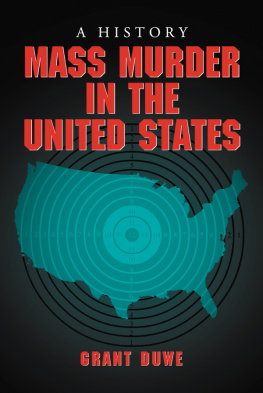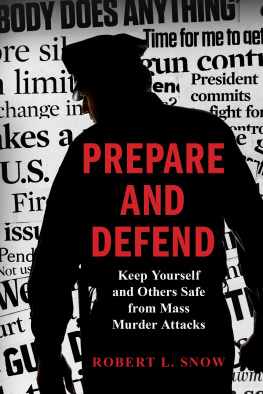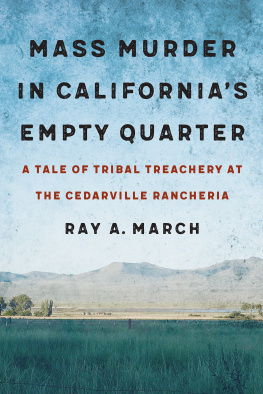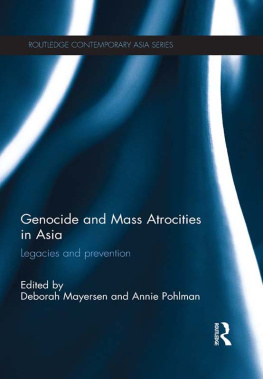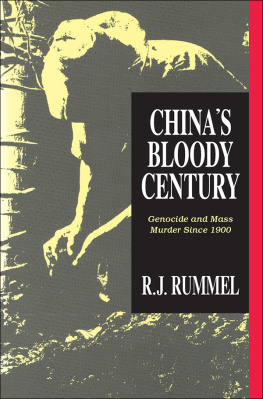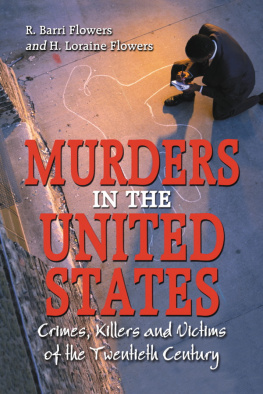
Table of Contents
LIBRARY OF CONGRESS CATALOGUING-IN-PUBLICATION DATA
Duwe, Grant, 1971
Mass murder in the United States : a history / Grant Duwe.
p. cm.
Includes bibliographical references and index.
ISBN-13: 978-0-7864-3150-2
1. Mass murderUnited States. 2. Criminal psychologyUnited States. 3. CriminalsIdentificationUnited States. 4. Mass murder investigationUnited States. I. Title.
HV6529.D89 2007
364.152'30973dc22 2007013518
British Library cataloguing data are available
2007 Grant Duwe. All rights reserved
No part of this book may be reproduced or transmitted in any form or by any means, electronic or mechanical, including photocopying or recording, or by any information storage and retrieval system, without permission in writing from the publisher.
Cover photograph 2007 Shutterstock
McFarland & Company, Inc., Publishers
Box 611, Jefferson, North Carolina 28640
www.mcfarlandpub.com
To my wife,
Susie
Preface
In the fall of 1991, the United States witnessed a series of highly publicized mass murders in which offenders used guns to kill publicly. In October, Joseph Harris, a postal worker, killed four in New Jersey. Later that same month, George Hennard gunned down 23 at a Lubys cafeteria in Killeen, Texas. The following month, another postal worker, Thomas McIlvane, murdered four co-workers at the post office in Royal Oak, Michigan, while graduate student Gang Lu killed five and wounded one more at the University of Iowa. And in December, Joe Johnson carried out a sniper attack in Missouri that claimed the lives of four victims.
My interest in the topic of mass murder was, to a large extent, precipitated by these widely publicized incidents. Like most, I imagine, I was interested in the why. Why would an individual go into his workplace and attempt to murder his co-workers? Or why would someone enter a restaurant and try to kill as many people as possible? In short, why do mass murderers commit such senseless acts of extreme violence?
As this book attests, my interest in the topic has shifted over the years. When I began studying mass murder, I quickly discovered that the five aforementioned cases that initially caught my attention were the exception rather than the norm. The most common form of mass murder involves a man who kills his wife and children, often in the privacy of their own home. This observation later led to my interest in the news medias coverage of mass killings and, in particular, the role it has played in the social construction of mass murder. Rather than defining social problems in terms of their objective conditions, the social constructionist perspective views them as the product of claimsmaking activity. Examining what others have claimed about mass murder ultimately led to my interest in its history. Most notably, many have claimed that mass murder is a historically new crime that was virtually non-existent prior to the mid1960s.
Reflecting these interests, this book explores the factors that have influenced the prevalence of mass murder in the U.S. In addition to describing the characteristics of mass murderers and the circumstances surrounding their crimes, this work examines the role of the news media in the social construction of mass murder. But perhaps most important, this book attempts to provide a history of mass murder in the U.S., a history firmly situated within the broader social, political, and economic context of the twentieth century.
Completing this book would not have been possible without the assistance from a number of individuals. Professors Gary Kleck, Ted Chiricos, and Jim Orcutt, all of Florida State University, provided valuable commentary on earlier versions of this research. I want to thank my parents, Richard and Mary Kay, for their support over the years. Last, but certainly not least, my deepest gratitude goes to my wife, Susie. Without her love and encouragement, finishing this book would have been impossible. Truly a blessing in ways too numerous to count, she is my little angel. Despite the help I have received along the way, any errors or omissions in this book are entirely my own.
Grant Duwe
Spring 2007
Introduction
Few mass murders are more notorious than the one committed by Richard Speck in Chicago on July 14, 1966. Shortly before midnight, Speck broke into a row house that served as a dormitory for eight student nurses. His crime ostensibly began as an attempted robbery. It quickly degenerated into wholesale slaughter, however, as he herded the young women into the back bedroom of the dormitory and then, one by one, led them to their deaths in other rooms. But Speck, in his alcohol-induced haze, lost track of how many women were in the back bedroom. A ninth student nurse, Corazon Amurao, survived the ordeal by hiding under a bed until she heard the ring of an alarm clock. Reasoning that Speck had left the premises, Amurao cautiously moved out of the back bedroom whereupon she discovered the bodies of her dead friends. Stumbling over their bloody corpses, Amurao made her way to the balcony, where she screamed hysterically, They are all dead! They are all dead! My friends are all dead! Oh God, Im the only one alive.
Though badly traumatized, Amurao was able to provide police with a positive identification of Speck. Two days later, he was found bleeding in a Chicago skid row hotel after he had slashed his wrists in an apparent suicide attempt. He was rushed to a local hospital, where he was apprehended after an emergency room physician recognized Speck from his picture in the newspaper. Convicted a year later, Speck was eventually sentenced to life in prison, where he died in 1991.
Looking back on the rampage twenty-five years later, criminologist Thomas Petee said in a 1991 newspaper article that the Speck case represents the first truly high-profile multiple murder case that we see (Houston Chronicle, December 6, 1991; Section A, p. 11). While the present study shows there is little truth to this claim, it is clear that his crime attracted an extraordinary amount of attention. It dominated the headlines both at home and abroad. Having taken place near the height of the Cold War, the mass murder was used by the former Soviet Union as a political cudgel to attack the United States. Red Star, the Soviet military newspaper, proclaimed, There is no need to seek the help of computers and other techniques to understand what social evil caused this crime. The reasons lie in the New York slums, the ghettos of Chicago and Los Angeles, in the childrens toys, books, and television programs which are raising American youth in the spirit of force (New York Times, July 17, 1966).
The Speck case was a major news event largely because it was widely regarded as one of the worst crimes ever committed in the United States. The mass killing was described by Time magazine (July 22, 1966; pp. 1921) as one of the most horrifying crimes in U.S. history, whereas the New York Times (July 15, 1966; Section A:1) declared that it was one of the most savage multiple murders in the history of crime. Coroner Andrew Toman, who worked on the case, said, In my six years as coroner, and in many years as police surgeon, I have never seen anything this bad. This is the crime of the century (Time, July 22, 1966; pp. 1921). Chicago police superintendent O.W. Wilson called it the most shocking crime since the 1929 St. Valentines Day Massacre, when seven members of the George Bugs Moran gang were lined up against a garage wall in Chicago and mowed down with machine guns (New York Times
Next page
